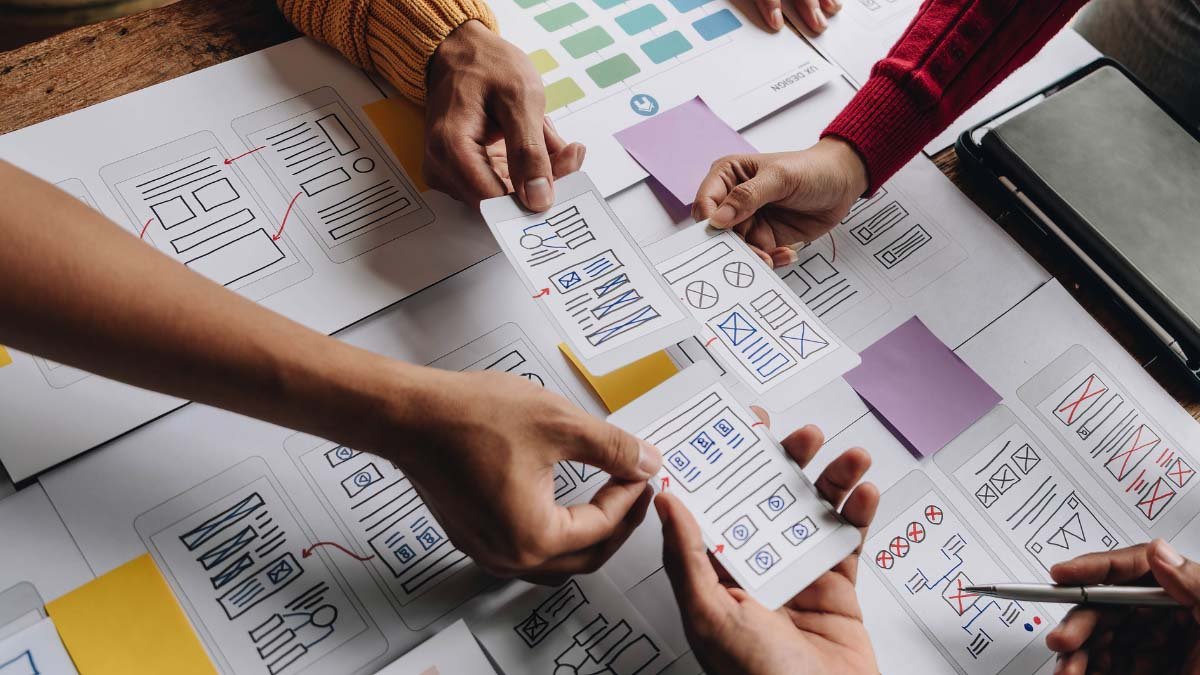Upon visiting a website, your initial focus is naturally drawn to its visual elements and design. The aesthetic presentation of a website’s layout plays a pivotal role in influencing how users engage with it. The visual design significantly shapes the user experience, moulding a customer’s digital journey.
What Is Visual Design in User Experience (UX)?
Visual design in User Experience (UX) is crafting a digital product’s visual elements and aesthetics, such as a website or app, to create a pleasing and engaging user interface. It encompasses layout, colour schemes, typography, imagery, and consistency. Visual design aims to make the product visually appealing and user-friendly, enhancing the overall user experience. It is crucial in guiding user interactions and perceptions and reinforcing brand identity.
Effective visual design ensures that content is well-organized, text is legible, and important elements are highlighted. Creating a balance between aesthetics and functionality is key, as a well-executed visual design can influence users’ emotional responses and their ability to navigate and understand the product. Ultimately, visual design in UX makes digital experiences more enjoyable and effective for users.
A visual design course can help you learn User Experience (UX) by equipping you with essential design skills such as layout, typography, and color theory. These skills are fundamental in creating aesthetically pleasing and user-friendly interfaces. Additionally, many visual design courses now integrate UX principles, teaching you to prioritize user needs and effectively communicate design choices. Furthermore, these courses often cover prototyping tools and techniques, which are invaluable for UX work. A visual design course provides a strong foundation for understanding and applying UX design principles.
What is the role of Visual Design in User Experience?
Visual design is pivotal in shaping digital products’ User Experience (UX), such as websites and applications. It uses various design elements to create aesthetically pleasing, functional, and intuitive interfaces that enhance the user experience. Here’s how visual design influences UX:
First Impressions: Visual design is what users first notice when interacting with a product. A visually appealing and well-structured interface can immediately engage and captivate users, setting a positive tone for their experience.
Aesthetic Appeal: Visual design focuses on colours, typography, layout, and imagery. These elements impact users’ emotional responses, making them feel comfortable, confident, and connected to the product.
Navigation and Readability: Clear and intuitive visual design helps users easily navigate the interface and find the necessary information. Proper use of typography and layout ensures that content is legible and comprehensible.
User Guidance: Visual hierarchy, achieved through design elements like contrasting colors and size variations, guides users’ attention to important content and calls to action, facilitating their journey through the product.
Branding and Recognition: Consistent branding elements in visual design, such as logos and color schemes, create a sense of familiarity and trust. Users tend to trust and remember products that maintain a cohesive visual identity.
Engagement: Visual design can make interactions enjoyable and interactive. Images, animations, and micro-interactions can enhance engagement and keep users returning.
Accessibility: An inclusive visual design approach to ensure that every user, including those with disabilities, can easily access and use the product, improving the overall UX.
Visual design in UX is about creating an interface that looks good and supports and enhances the user’s journey. It’s a crucial component that can either attract and retain users or drive them away, making it essential in designing products that provide a positive, effective, and memorable user experience.
How is visual design related to a product’s success?
Is visual design a universal determinant of success for all products? Not necessarily. It’s not a one-size-fits-all scenario where every business must prioritize visual design for increased revenue or conversions. However, in online businesses and startups, the impact of visual design on the user experience is often paramount.
The relationship between visual design and a product’s success resembles the chicken-and-egg paradox. It’s challenging to ascertain whether a product succeeds because of its visual design or whether an excellent product is a prerequisite for exceptional design.
Nevertheless, many products significantly benefit from emphasizing visual design throughout their website development. Visual design should be integrated from the project’s inception because it shapes how users interact with the site, influences their perception of its usability, impacts their time spent on it (and elsewhere), and determines their likelihood of returning in the future. In this context, visual design plays a pivotal role in shaping the UX and can be an important factor in the success of online ventures.
Can Visual Design Create a Better UX?
Let’s explore how visual design plays a significant role in enhancing the user experience. There are various ways in which visual design impacts user interactions. But how can you leverage visual design to create a superior UX for your audience? Here are four key elements that contribute to improving UX through visual design:
Consistent Design: Inconsistencies in design leave a negative impression, making the user experience confusing and frustrating. To ensure user comfort, elements should look appealing and maintain consistency. Designers often plan the website layout and experiment with different styles to determine the best fit for their niche.
Visual Hierarchy: Each page should establish a clear visual hierarchy, aiding users in scanning information effortlessly. It grabs users’ attention and keeps them engaged with the content. Neglecting visual hierarchy is a common mistake that can hinder users’ comprehension of the product.
Testing Visual Concepts: Visual elements, such as images and color composition, are vital in how users perceive information. It’s essential to test these concepts based on user feedback. Designers employ prototyping and MVP development to assess usability and responsiveness, ensuring that the design aligns with user expectations and provides a positive experience.
Trends Analysis: Staying updated with design trends is crucial. Users prefer familiar interfaces, so incorporating the latest trends into your website’s design can give you an advantage. Instead of extensive research and development, conducting market trend analysis specific to your niche can provide insights that set you apart from competitors, enabling you to experiment with different layouts and frameworks.
Conclusion
Visual design’s role in user experience goes beyond making a website visually appealing; it also entails guiding users seamlessly through the interface. Specific aspects of visual design are responsible for significantly improving the overall user experience, making them indispensable. To craft a successful website design that boosts conversion rates and keeps users engaged for longer, it’s essential to incorporate the most effective visual components into your design.
The moment is ideal for pursuing a visual design course because of the increasing demand for skilled industrial designers. In an ever-expanding digital landscape, the ability to create visually appealing and user-friendly interfaces is invaluable, offering ample career opportunities and the chance to stay at the forefront of design trends.




